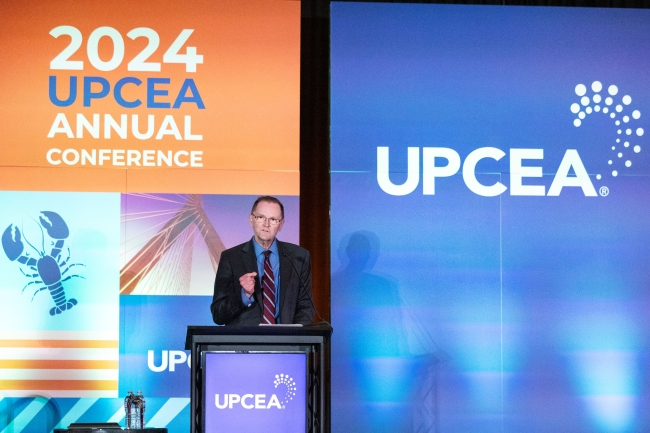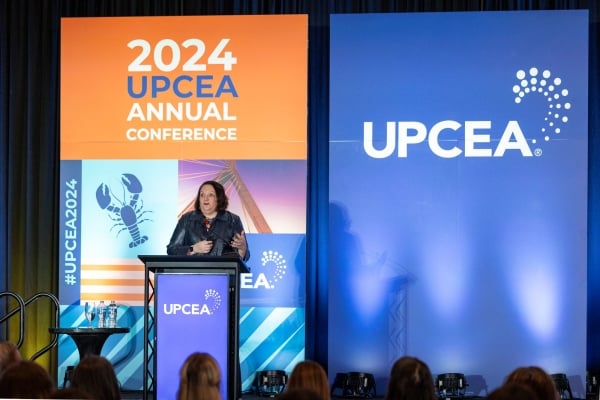You have /5 articles left.
Sign up for a free account or log in.

Bob Hansen, CEO of UPCEA, speaks at its annual conference.
Photo/Julia Zhogina
A looming enrollment cliff—expected to bring a massive dip in traditional-aged students—cast a shadow over conversations at the annual UPCEA conference last week.
But many attendees at the online education–focused event in Boston sought to brighten the mood with solutions and tactics that included embracing artificial intelligence and pursuing personalized learning bolstered by microcredentials.
“We’re at a unique moment where it’s a once-in-a-generation time to reinvent higher education,” Bob Hansen, UPCEA’s chief executive officer, told Inside Higher Ed at the event. “You have to have a realistic understanding of turning the ship around in a Panama Canal; it’s not easy to do and they’re not turned around overnight.”
Hansen, who has been with UPCEA (formerly known as the University Professional and Continuing Education Association) for over a dozen years, said he believes educators are seeking more solutions than ever. UPCEA sold out its three-day event in record time, hitting the 1,200-person conference limit.
“It’s a lot of opportunity, but there’s also a lot of fear on the part of the central administration,” Hansen said. “And they turn to us looking for answers.”
A top answer mentioned in keynote talks and peppered throughout panels was personalized learning, which aims to support students’ various wants and needs, versus a standardized approach.
“We say we’re ‘student first’ but a lot of times it’s ‘us first’—we’re not embracing the needs of the students,” said Whitnie Powell, assistant vice president of Indiana University’s enrollment management and student services.
IU’s office of online education spent more than two and a half years implementing multiple enrollment terms, allowing students to enroll beyond the strict deadlines of once in the fall and once in the spring.
“You hear a lot of ‘no’s before you get to the ‘yes’ and that’s OK; that’s part of the process,” Powell advised. “Find the allies and get the right people around the table to make it happen.”
Microcredentials also cropped up under the personalized learning umbrella. Depending on the institution, microcredentials allow students to learn or showcase a skill within a course. That skill can be added to résumés or shared on social media accounts and used by students to market themselves.
“There’s a reason we’re all talking about it now with the enrollment cliff,” said Matt DiPirro, associate dean of liberal arts at Southern New Hampshire University. He spoke during the session called Digital Credentials as a Catalyst for Change.
[Microcredentials] can entice students to persist or entice prospective students,” he said. “It’s creating a more personalized experience and trying to meet learners where they are.”
Maria Flynn, CEO and president at Jobs for the Future, pointed to the rise of LinkedIn and Google offering low-cost certificate models.
“Too many higher ed institutions have not been learner-driven or demand-driven enough and instead, fall back on old traditions, narratives and stories on how four-year degrees are the only path to advancement or their own bottom line,” said Flynn, who gave the second day’s keynote.

Maria Flynn, CEO of Jobs for the Future.
Photo/Julia Zhogina
Artificial intelligence also came up as an enrollment cliff antidote.
“We’re at the very beginning of an AI revolution and you have got to be ready for what’s coming,” said AI expert Ian Khan, a self-described ‘futurist’ and another keynote speaker. “We need to accelerate our pace just a little bit to be in pace with the times.”
While AI is a pervasive topic, both in higher education and beyond, UPCEA deliberately kept it in check at the conference to remind attendees about the importance of diversifying options and revenue, Hansen said.
“One of higher education’s biggest challenges is they think it’s not a business,” Hansen said. “In some ways, it’s not, but if you don’t approach it with an entrepreneurial mindset, you may not survive.”





